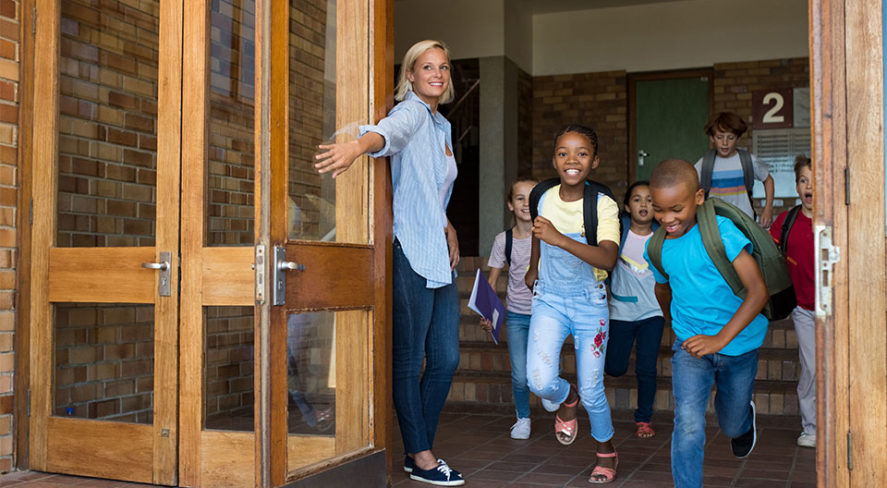Federal School Security Grants From the School Violence Prevention Program

New Resource: SIA Guide to School Security Funding
Updated November 2023
 More than ever before, education leaders are seeking security enhancements to their facilities as part of their comprehensive school safety strategies. The Security Industry Association (SIA) is pleased to introduce the SIA Guide to School Security Funding in response to the need for more centralized information on the variety of sources of funding available specifically for K-12 school security solutions. In this informative guide, explore:
More than ever before, education leaders are seeking security enhancements to their facilities as part of their comprehensive school safety strategies. The Security Industry Association (SIA) is pleased to introduce the SIA Guide to School Security Funding in response to the need for more centralized information on the variety of sources of funding available specifically for K-12 school security solutions. In this informative guide, explore:
- Primary sources of funding for school security improvements
- Details of key federal and state grant programs focused on school security technology, equipment and related uses, including details on eligibility, allowable uses and requirements, available funds, points of contact and how to apply
- Key supporting documents, resources and links for grant applications
- Information on state-specific security requirements
- Details on cooperative purchasing mechanisms using the General Services Administration Schedule contract and other programs for state and local government
Access the SIA School Security Funding Guide (free for SIA members!) here.
Information on School Violence Prevention Program (SVPP) grants, including program eligibility, application process, uses and funding amounts
Updated April 16, 2019
The U.S. Department of Justice (DOJ) has announced the School Violence Prevention Program (SVPP), created through the 2018 enactment of the STOP School Violence Act, which Congress authorized to provide $33 million in grant assistance for security improvements annually through 2028. The purpose of the program is “to improve security at schools and on school grounds in the jurisdiction of the grantee through evidence-based school safety programs.”
SVPP awarded nearly $25 million in grant funding for fiscal 2018. According to the SVPP post-award fact sheet, 91 grants were distributed to recipients in 33 states, and the most common project elements were camera systems, access controls (e.g., doors, locks), communications technology (e.g., panic alarms, radios, repeaters), expedited notification to law enforcement, training for law enforcement and visitor management technologies.
The application process for 2019 is now open through May 31. Importantly for school districts, a new clarification allows SVPP applications to be submitted directly by local districts, police departments and sheriffs departments in addition to units of "general" government (city, county, township, etc.). $25 million in grant funding is available for fiscal 2019, consisting of 24-month awards up to a maximum of $500,000 and requiring a local cash match of 25 percent.
Closely resembling the former Secure Our Schools program at DOJ, SVPP is expected to help schools implement emergency communications systems, video surveillance, campus access and classroom entrance control technology, fortified entrances, law enforcement training and other measures.
Allowable Uses
- Acquisition and installation of technology for expedited notification of local law enforcement during an emergency (this is a new emphasis in the program)
- Coordination with local law enforcement
- Placement and use of metal detectors, locks, lighting and other deterrent measures
- Training for local law enforcement officers to “prevent student violence against others and self”
- Any other measure that, in the determination of the director of the Office of Community Oriented Policing Services, may provide a significant improvement in security
Allowable Costs (Highlights)
Equipment
- Entry control
- Intrusion alarm systems
- Screening equipment
- Security lighting
Other Technology
- Two-way radios
- Duress alarm systems
- Emergency alerts/communication systems
- Identification/visitor management
- School facility mapping
- Bus tracking/route mapping
- Video surveillance technology
Additional Uses
- Salary/benefits for coordination personnel (non-sworn, civilian)
- Supplies
- Travel/training
- Consultant services
Non-Allowable Costs (Highlights)
- Salary/benefits for sworn personnel
- Security guards
- Armored or weaponized vehicles
- Bulletproof vests
- Firearms/related training
- Radar guns
- Tasers
- Animals
Qualifications
Applicants are required to use “evidence-based” programs and processes to ensure accountability in the program to ensure taxpayer dollars are spent to support programs, technology and equipment that are effective. Understandably, the “evidence-based” requirement is defined differently for training programs and other behavioral interventions than for technology and equipment: for the latter, grant applicants can rely upon the significant and growing body of work on school security best practices to validate technology and equipment needs. These have been identified in part through public commissions and task forces throughout the country established to provide recommendations, formulate guidelines and set standards for school security. Examples include the Federal Commission on School Safety, the Marjory Stoneman Douglas High School Public Safety Commission, the Sandy Hook Advisory Commission and the Indiana School Safety Guidelines, but more than a dozen states have established guidelines or set standards and many others are working to do the same.
Best practices have also been developed through collaboration between public and private sector security experts. SIA supports the Partner Alliance for Safer Schools (PASS) in its mission to provide the tools needed to implement a layered and tiered approach to safe school environments based on individual needs, nationwide best practices and the most effective use of resources available. See the PASS Safety and Security Guidelines for K-12 Schools. The Guidelines were recently recognized by several state and federal school safety initiatives.
Importantly, the definition requires security solutions to be code compliant, which helps ensure professional installation and use of products that are appropriate for the school setting.
Key Security Best Practices Resources for Grant Applicants
- PASS Safety and Security Guidelines for K-12 Schools
- Sandy Hook Commission Recommendations
- Connecticut School Safety and Security Plan Standards
- Indiana School Safety Guidelines
- New Jersey School Safety Task Force
- Texas Unified School Safety and Security Standards
- U.S. Secret Service Operational Guide for Preventing Targeted School Violence
- U.S. Department of Homeland Security (DHS) K-12 School Security Guide and School Security Survey
- DHS Building and Infrastructure Protection Series: Primer to Design Safe School Projects (FEMA-428/BIPS-07)
- Final Report of the Federal Commission on School Safety
- Marjory Stoneman Douglas High School Public Safety Commission
- Secure Schools Alliance Research and Education (information on state-level school security programs, recommendations and standards)
While many states have yet to establish specific school facility security requirements, most common are:
- Restricted visitor access and sign-in
- Exterior access controls
- Crime prevention through environmental design
- Two-way communications in classrooms and other areas
- Interior access controls/locks
- Panic/emergency notification systems
- Electronic surveillance
- Bullet/blast resistant materials
- Staff and student IDs and access management
While many states have yet to establish specific school facility security requirements, most common are:
- Restricted visitor access and sign-in
- Exterior access controls
- Crime Prevention Through Environmental Design (CPTED)
- Two-way communications in classrooms and other areas
- Interior access controls/locks
- Panic/emergency notification systems
- Electronic surveillance
- Bullet/blast resistant materials
- Staff and student IDs and access management
